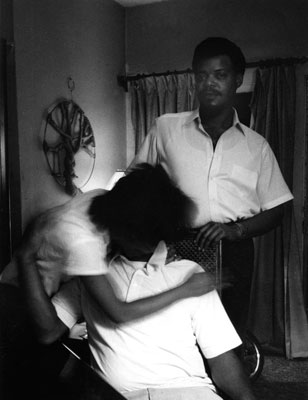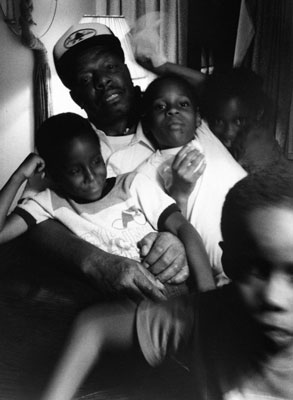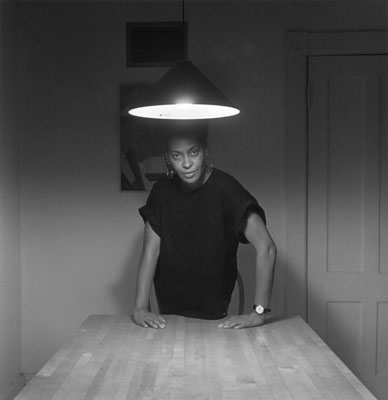There was nothing subtle about Kara Walker’s gargantuan installation inside the old 19th century building of the Domino Sugar Factory that closed in 2004. After Walker’s “A Subtlety” comes to a close, it would be taken down to make way for luxury rise condos even for a building with such rich history. Sugar Baby lay in the deep recesses of the old factory as a last hurrah for the rich albeit dark history surrounding the sweet but bloody sugar industry. The giant marvelous and highly sexualized sphinx stood there as a sweet reminder that the golden age of industrialism in the 18th and 19th century was fueled by the blood and sweat of the Caribbean slave trade.
During NPR’s Audie Cornish time with Walker in the factory, Walker explains that much like blood diamond, “Basically, it was blood sugar,” she continued,” today, there were pamphlets saying this sugar has blood on its hands.” Walker narrates that to produce the refined sugar, slaves would feed the large miller with canes by hand and that it was a dangerous process: Limbs and lives were lost to provide the Western world with its sugar. (Cornish) Much like the walls in the factory, the story attributed to refined sugar is draped in melting sugar and rust.
Much of Walker’s career has produced works that gives a sense of a “giddy discomfort” as she puts it. Her work continuously raises issues of race, the female body, sexuality, inequality, slavery, intense graphic violence oppression and the sullied power that comes from it. Born in 1969 in Stockton, California, Walker, at age 13, moved to Stone Mountain in Atlanta when her father accepted a position at Georgia State University. Walker recalls a time when she watched her father draw in his studio that she remembered thinking, “I want to do that, too”. At around the age 2 ½ or 3 she said that she decided that she was going to be an artist like her father. She received her BFA from Atlanta College of Art back in 1991 and a MFA degree from Rhode Island School of Design in 1994. 3 years after receiving her MFA degree she was included in the Biennial exhibition in 1997 at the Whitney Museum of American Art in New York. Being the youngest recipient of the prestigious John D. and Catherine T. MacArthur Foundation’s grant, her work garnered a huge controversy among the public.
One of her most highly sensationalized work was her cut-paper silhouettes that she started working with in 1993 during her graduate studies in Rhode Island School of Design. Paper-cut portraits were dated back in the late 16th century in France to the court of Catherine de Medici. In the 1700s silhouette-cutting became an art form due to popularity among the rich but in mid-1800s “shadow-portraits” became more of a craft than art and was mostly used in carnivals and in the classrooms to train “good ladies”. Tied to its 18th century phenomenon of physiognomy, an old “science” claiming that a person’s outer appearance, mainly the face, or profile determines one’s character or personality, Walker uses this as a tool to bring the history of racial representation. She draws the images on black paper using pencil or crayon then cuts them with an X-ACTO knife. The form of the images seems like a caricature reduction of the characters and because everything is reduced to a silhouette of the same color, it made them invisible and gave them anonymity as Walker explains. The cut outs are then fastened to canvas, paper or wood using wax or sometimes like her work, Slavery! Slavery! Presenting a GRAND and LIFELIKE Panoramic Journey into Picturesque Southern Slavery or "Life at 'Ol' Virginny's Hole' (sketches from Plantation Life)" See the Peculiar Institution as never before! All cut from black paper by the able hand of Kara Elizabeth Walker, an Emancipated Negress and leader in her Cause 1997, she sometimes adheres her work directly on the gallery walls
Slavery! Slavery! Presenting a GRAND and LIFELIKE Panoramic Journey into Picturesque Southern Slavery or "Life at 'Ol' Virginny's Hole' (sketches from Plantation Life)" See the Peculiar Institution as never before! All cut from black paper by the able hand of Kara Elizabeth Walker, an Emancipated Negress and leader in her Cause 1997
Walker had started exhibiting large scale cut-paper silhouettes in 1994 at the Drawing Center in New York. The piece entitled, Gone: An Historical Romance of a Civil War as It Occurred Between the Dusky Thighs of One Young Negress and Her Heart, was described by Nato Thompson, Chief Currator of Creative Time, to be depicting a “Historical Romance” bursting with sex and violence and adds that the “difficult blend leaves the viewer unsettled.” Her work was not without controversy. Back in the 90s Thompson relates that at the time that she was thrust into the limelight some established artists called her work racist and recently back in 2012-13, her work, The moral arc of history ideally bends toward justice but just as soon as not curves back around toward barbarism, sadism and unrestrained chaos, revolted and shocked many people because it depicted Obama giving a speech with graphic violence all over the work which represented the horrors in the antebellum in the South including “a white man shoving a black woman’s face into his crotch.” (N. Thompson) The public library covered the artwork for two weeks until they decided that in order to handle the delicate matter and to exhibit the drawing again, they held a public discussion with Walker.
Walker is also keen in using a narrative type of depicting her work. Her work tends to be derived from historical romantic fiction and to 19th century narratives of slaves about the life during the antebellum in the South. Titles of her work lean towards a very theatrical impression and she also tends to spell slang words the way that they are pronounced like the divisive shadow-puppet film, Fall Frum Grace, Miss Pipi's Blue Tale.
A 400-foot cyclorama of the Civil War conflict that she saw when she was young influenced her to Construct her work, Slavery! Slavery! in the same manner. The 360-degree installation surrounding the viewer asserts them to submit into participating in the story “as if spying on the events taking place”. Being in a rotunda also takes the fact that it eliminates a definite beginning or end to the story.
Gone: An Historical Romance of a Civil War as It Occurred Between the Dusky Thighs of One Young Negress and Her Heart,
Image from NYCLOVESNYC
Kara Walker started her career as a painter. Back in the Atlanta School of Art, she worked with oil as an undergrad student and when she graduated and attended Rhode Island for School of Design in 1994, she began working on cut-paper silhouettes. She associated the medium she uses to its history and because of that she coupled oil painting to the upper class. Walker explains that she had to wean herself to the oil painting’s “obvious seduction” and added that she was determined to be better and to “make work that would actually stimulate others” With the silhouette, she was able to have more autonomy in exploring issues about race and exchanges in power. (K. Walker)
In exploring shadow making with her silhouettes, in Darkytown Rebellion, she used light projection to cast shadows and create a swallowing atmosphere for the viewers in her installations. The paper-cut silhouettes are plastered on the wall then projects colors using transparencies on the overhead projectors. Because their shadows tend to get cast because of the light projection, viewers become part of the installation and the story.
Image from CAVETOCANVAS
Besides being theatrical with her works, she also sometimes worked on some of her pieces like she would write to her diary. She constantly draws and creates sketches in notebooks like the series of 66 works on paper, Do You Like Crème in Your Coffee and Chocolate in Your Milk? (1997). While it was definitely smaller in scale compared to her large installations, they are quite powerful as these were her personal responses to public criticism of her work at the time. She also worked with Text-based works like Texts (2001) and Many Black Women (Certain Types) (2002) which was a text based work and it involves sentences, phrases and quotes that seemed to be notes that she writes for herself. In a larger scale, she also used this medium for Letter from a Black Girl (1998) which explores the power-exchange between master and slave and the artist and the art world possibly as a response to the criticism she received from the public and other artists who called her “racist” (N. Thompson)due to the dark nature of her work.
She further explored the use of silhouette, light projection, and storytelling when she delved into film animation. In her silhouette puppet animation, Fall Frum Grace, Miss Pipi's Blue Tale, Walker uses violence titillated with sex and narrates things that grueling and are taboo for the history of Slavery America.
Fall Frum Grace, Miss Pipi's Blue Tale (2011)
Image from lehmannmaupin
Her latest piece, A Subtlety, is a massive installation used a medium that is within time constraint stage in a place that has been doomed of its existence. Walking towards the building, people immediately would notice the smell of sugar and molasses within the air acting like a luring agent to the giant confection waiting inside its walls. Audie Cornish puts it best, “She’s doing what she does best: drawing you in with something sweet, something almost charming, before you realize you’ve admired something disturbing.” Walker worked with sugar to bring to light its history, its production, and at what cost a refined white sugar took to achieve its “purity”. The story of great empires that were built using the lives of slaves were highlighted by the use of the sphinx to mirror the American slave history to enjoy the luxury it provided and to allow its culture of overconsumption.
Walker’s work is not without criticism because it constantly brings us to a position that is completely uncomfortable because of violence, sex, nudity, racism, slavery, dehumanizing people for power, antebellum in the South, and how such injustice was a part of a golden age in America’s industrial history wrapped in squeamish humor. To feel a negative emotion towards her work seems to be a victory of the artist’s part because it brings to light a moral compass within ourselves that we need to constantly remind the world that such horrors should never be allowed to happen again.
References:
http://creativetime.org/projects/karawalker/domino-sugar-factory/
http://ny.curbed.com/archives/2014/05/23/artist_kara_walker_says_farewell_to_the_domino_sugar_refinery.php
http://learn.walkerart.org/karawalker/Main/DesireAndShame
http://creativetime.org/projects/karawalker/curatorial-statement/
http://www.moma.org/collection/object.php?object_id=110565
http://www.washingtonpost.com/news/morning-mix/wp/2014/05/27/going-to-see-kara-walkers-subtlety-read-these-first/
http://www.nytimes.com/2014/05/12/arts/design/a-subtlety-or-the-marvelous-sugar-baby-at-the-domino-plant.html?_r=1
http://learn.walkerart.org/karawalker/Main/Biography
http://learn.walkerart.org/karawalker/Main/TechniquesAndMedia



























































